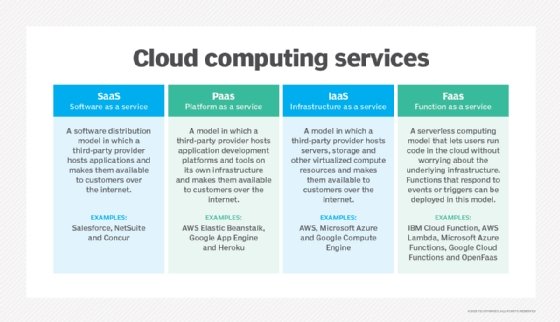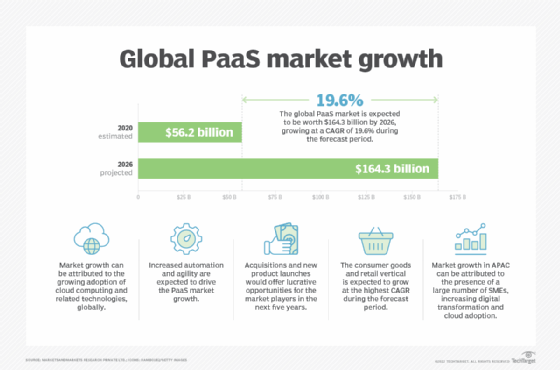
Getty Images/iStockphoto
The state of the PaaS business model and market in 2022
PaaS fills the gap between IaaS and SaaS for developers and comes with its own benefits and challenges, which inform the PaaS business model and market.
PaaS is a cloud computing model where a third-party provider delivers hardware and software tools to users over the internet. As such, PaaS enables developers to develop or run new applications without having to install in-house hardware and software.
PaaS got its start with a service called Zimki, launched out of Canon's Europe-based Fotango in 2005. It removed some of the repetitive tasks from development of JavaScript web apps in a pay-as-you-go model, said Scott Cameron, senior architect at Insight, an IT provider in Temple, Ariz. In 2007, Zimki stopped running because Fotango didn't want to focus on it any longer.
When Google Cloud Platform was introduced in 2008, it launched App Engine, a PaaS system that was originally limited to 10,000 developers, according to Cameron. App Engine let customers run their web apps on Google infrastructure, and it's still around today.
"PaaS offerings began finding wide-scale use a little over a decade ago, shortly after the emergence of infrastructure as a service," said Tim Potter, principal of Deloitte Consulting.
Initial PaaS offerings focused on web application development with a marketplace focus on startups or small firms. Over time, the market has evolved in two dimensions: the breadth of PaaS use cases and the providers. Today, PaaS offerings -- or more aptly, managed offerings -- extend beyond compute to include databases, machine learning (ML), security, operations and network offerings, Potter said.
"Increasingly, we are seeing [IaaS] providers, i.e., public cloud service providers, move 'up the stack' to offer PaaS services that reduce the administration burden on engineers building solutions on their core infrastructure services," Potter said. "Similarly, SaaS providers move 'down the stack' to provide their customers the ability to create custom solutions that integrate tightly with their core software systems."
IaaS vs. PaaS vs. SaaS
IaaS, PaaS and SaaS are unique cloud computing offering categories with their own use cases, Potter said.
IaaS delivers core infrastructure services, e.g., networks, compute and storage. PaaS delivers platform tools for application or service development, he said. PaaS is built on top of core infrastructure services. SaaS delivers complete applications that serve specific business needs, typically with options that enable configuration and slight customization.
"Each category provides a different level of technical flexibility and accompanying operational complexity," Potter said. "PaaS is significantly less complex than IaaS to manage. The reduction in complexity comes at the cost of flexibility -- engineers are bound by the scope of services offered by the PaaS platform. Conversely, PaaS services offer greater flexibility than SaaS solutions, but at the cost of added operational complexity. Pizza is often used as an analogy for describing IaaS-PaaS-SaaS differences. IaaS is likened to take and bake, PaaS to pizza delivery and SaaS to dining out."
At the most general level, PaaS is a set of development services aligned with a public cloud provider and/or a multi-cloud container development platform, said Lee Sustar, an analyst at Forrester Research. This has evolved as cloud providers have woven managed services throughout their IaaS and PaaS. Today, it's more appropriate to group PaaS as part of cloud development services that typically include database services, big data, AI/ML and IoT.

IaaS
IaaS gives the customer the most control, flexibility and availability on the cloud, said Michael Gibbs, CEO of Go Cloud Architects, an educational organization focused on cloud computing technologies and based in Port St. Lucie, Fla. IaaS is effectively using the cloud as a virtual rented data center.
"IaaS may cost more than PaaS," Gibbs said. "And IaaS does require more management overhead than PaaS, and it requires more sophisticated personnel."
IaaS, SaaS and PaaS are all about reducing the complexity of information technology, Cameron said.
"In information technology, you have a lot of overhead in managing physical and virtual infrastructure," he said. "You have hardware and software refreshes, and licensing, and patching, and administration. All of those are very manual-intensive and create regular or ongoing challenges for IT departments."
IaaS organizations reduce the complexity of managing the compute and storage of physical infrastructure for servers -- they can create VMs without worrying about the underlying infrastructure as long as there is sufficient capacity allocated to the system, according to Cameron.
"Someone still needs to manage everything -- physical hardware, virtual and the servers -- but you can start to separate those roles out easier and outsource to a cloud vendor if you like," he said.
SaaS
SaaS reduces the complexity even more than with IaaS -- divorcing a company's consumption of IT from the underlying platform almost entirely, Cameron said. All the company has to worry about is bringing its data to the system or interacting with an application. The physical and virtual bits below the application simply aren't relevant to the organization and are included in the cost of the service.
"[One] concern with SaaS is that you have no control of the application," Gibbs said. "If the SaaS provider does not have a high availability strategy and the SaaS provider has an outage, all their customers will lose service."
In addition, SaaS applications often have less flexibility than custom-delivered applications on either IaaS or PaaS, according to Gibbs.
PaaS
PaaS fills a gap between IaaS and SaaS, Cameron said. It was born out of a frustration with managing increasingly complex IT infrastructure.
"We needed to give IT consumers the ability to use pre-configured services to build more complex applications without understanding or having to manage the underlying infrastructure," he said. "This allowed us to rapidly create and deploy applications comprised of building blocks and helps to remove the latency of engaging the information technology organization from bringing that value to customers -- internal or external."
With PaaS, environments scale as needed, Gibbs said. PaaS environments can also be more agile, enabling faster deployment and development of new applications. PaaS enables organizations to reduce overhead because the cloud provider performs much of the management.
PaaS is the cloud computing technology of choice for developers, said Tony DiGiorgio, chief architect at Symplr, a provider of healthcare governance, risk management and compliance tools.
"It is a technology framework or environment that provides a space for developers to build applications without worrying about the infrastructure underneath," he said.
Organizations that use PaaS vendors can stay focused on designing and building new capabilities and features into their products, and ultimately deliver those products to their clients faster, DiGiorgio said. Companies that use PaaS services don't have to worry about the underlying management around updating servers, patching OSes and other maintenance tasks required to maintain digital environments.
An example of a PaaS offering is AWS Elastic Beanstalk, which helps developers deploy apps on the AWS cloud. Other PaaS providers include Salesforce, Alibaba Cloud, Oracle, SAP, VMware and Microsoft Azure. The IBM Cloud platform combines PaaS with IaaS to provide an integrated experience.
Benefits and challenges of PaaS
PaaS offerings give developers the ability to build their applications more quickly by offering pre-built solutions to many of the common problems that developers encounter, said Mohammad Hashemi, co-founder of Gadget, a developer productivity company in Ottawa. They also greatly decrease the cost and effort associated with scaling applications because the platform handles much of that.
In addition, PaaS delivers a framework that developers can use to create customized applications.
Another benefit of PaaS is that the responsibility for continuity of the service doesn't fall entirely on an organization's shoulders, said Pavel Kuznetsov, deputy managing director of cybersecurity technologies at Moscow-based Positive Technologies.
"For enterprises that contribute to the service with their own code and tools, they share this responsibility with the PaaS provider, and for organizations that don't contribute their own code or tools, the responsibility falls entirely on the PaaS provider, which is even better," Kuznetsov said. "Organizations also don't need to hire support for the service anymore."
The challenge is taking advantage of native cloud services while mitigating the risk of lock-in to the platform or its underlying infrastructure, which is a growing concern as multi-cloud strategies are adopted by enterprises and large governmental organizations, according to Sustar.
Gibbs said that the challenges of PaaS include the following:
- PaaS environments remove all control from the user.
- To use a PaaS environment, the organization must recode its applications. This might be prohibitively expensive.
- With PaaS, once the customer recodes its application, it will be extremely challenging to leave that cloud provider. Therefore, PaaS promotes vendor lock-in.
- The organization has no control over security in the PaaS environment. So if an organization desires greater security than offered by the PaaS service, it has no options.
COVID-19's effect on the PaaS market
"The global pandemic has been an accelerator event, driving organizations to bring forward and collapse multiyear programs into shorter time frames to address the demands of new flexible ways of working," said John Rostern, senior vice president and global lead of cloud and infrastructure security services at NCC Group, a consultancy based in Manchester, England.
PaaS enables organizations to get to production faster and easier, he said. Business demands to get to value sooner are driving the practicality of putting PaaS at the end of the CI/CD pipeline, an evolution supported by the development community that has always preferred to focus on code rather than building and maintaining infrastructure.
"The flip side to this is the age-old skills gap, with cloud skills already in high demand being compounded by adding developer PaaS talent to the priority list," Rostern said.
As in most every industry, COVID-19 will have a major effect in the overall spend growth on the PaaS market over the next five to 10 years, according to DiGiorgio.
"Because businesses were forced to adopt and work differently, they needed technology that provided more nimble options for developers -- hence the pandemic resulted in a more pervasive adoption of PaaS technology," he said.
PaaS has evolved a lot in the last few years and is blending with IaaS, said Becky Trevino, vice president of product marketing at Snow Software in Stockholm. PaaS consumption is increasing as the traditional IaaS consumers have matured and are more comfortable putting services in the cloud, whether it's IaaS or PaaS. COVID-19 has also affected PaaS market growth by accelerating this blending of PaaS and IaaS.
"Because organizations were forced to adopt the cloud and accelerate their digital transformation, these organizations began examining how they could offload other tasks," Trevino said.
COVID-19 certainly increased the demand for digital services and put pressure on developer teams to ship faster, said Tyler Jewell, managing director at Dell Technologies Capital, the venture capital arm of Dell Technologies. However, while PaaS businesses grew in 2021, they didn't grow at a faster rate than they did prior to COVID-19, he said.

The PaaS market in 2022 and beyond
PaaS is the new IaaS, according to Insight's Cameron. In 2019-2020, the second or third big wave of IaaS cloud movers had completed full or partial uplifts to the cloud, and many of those that weren't moving at that time started updating skills and strategies to begin their own cloud journeys.
A lot of them learned the lessons of those who came before -- they started to upskill their staff, update processes and think about what it really meant to move to the cloud rather than just throwing a few virtual machines on a public cloud platform, he said.
"There is also a lot more general experience with cloud platforms in the market at this point -- engineers are starting to get a good idea where IaaS and PaaS and SaaS all fit within their IT services stacks and how to optimize placement of workloads on the optimal platforms," Cameron said. "Hybrid and multi-cloud are now the default rather than the exception -- most customers are starting with a much more nuanced and realistic vision of where public cloud fits in their organizations."
Positive Technologies' Kuznetsov said that the leading PaaS trend in 2022 will be the further enhancement of computing powers -- essentially, the urge to integrate with edge computing before reaching the clients themselves.
"But we need the next computing technology breakthrough," he said. "Instead of building more data centers, the industry should devise a plan to significantly raise the quality of computing, e.g., practically implement quantum computers and start using them en masse."
"As for the future, half a glance at the booming PaaS vendor market will speak volumes, with AI platform as a service tipped as the next hot topic already well warmed up," NCC Group's Rostern said.
Indeed, the PaaS market size is expected to grow from an estimated $56.2 billion in 2020 to $164.3 billion by 2026, according to a research report from MarketsandMarkets.
Expect to see vendors increasingly consolidating IaaS and SaaS functionality into PaaS, and leading PaaS through its maturity cycles to establish standards and practices, Rostern said. Only then will it hit true escape velocity, and we can expect to see PaaS cyber hygiene stability hit its full stride.
"In the market today and across our clients, we observe two consistent themes," Deloitte's Potter said. "One, the importance of data-driven decisions at scale to maximize customer value and open new market offerings. Two, the refocus of talent to high-value activities using automation to replace low-value activities."
With those two themes considered, in 2022, ML-focused PaaS offerings will mature and better integrate with the provider's service ecosystem and enable engineers to bring data-driven solutions to market faster, Potter said.
Given the increasing adoption of PaaS platforms -- which Deloitte doesn't expect to slow down -- technology firms will continue to place significant investment in their PaaS offerings in 2022 and beyond, he said.








